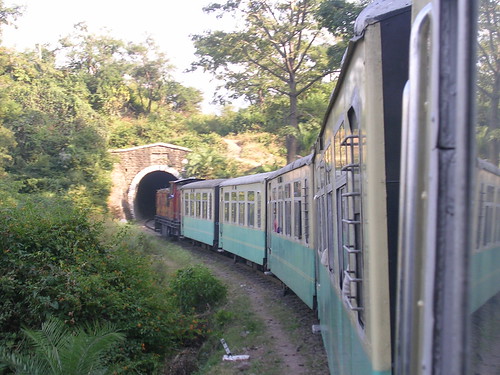I went to shimla in November of 2006, I think one day after Diwali. Our tickets were not confirmed from Kalka to Shimla. We took 2 tier AC from New Delhi and went to Kalka. I must admit that the Delhi Railway station was in very bad condition. You could see people lieing on the ground and it was full of people.
I ate a dish made with milk I don’t remember the name, but it was like yogurt. It was really good and was served in Kullars. We waiting and waiting and finally I saw train coming on the platform. We were not able to locate our seat and when we were oh god, it was full and we had the top births. Anyway it was night so I tried to sleep but couldn’t as I was worried about the money and stuff I am carrying. I couldn’t sleep properly and we were at Kalka at around 6 am. When we came out I noticed that I dropped my Cell phone in the train and I had to run back and fortunately it was there and I got it.
It was critical point of getting a seat in the train. We couldn’t get any seats as people just took all available seats and we jumped into 3rd class and had to sit on benches. My uncle who went with me to shimla is an retired railway officer. He was at some higher post so he talked to Ticket Collector, and we made an arrangement with him. We got moved to first class now with a payment of Rs. 200 to TT. It's about $5. Anyways we shared our own cabin with some Bangali family.
They were nice and I guess were not from India. We enjoyed our journey and I took so many pictures and for more pictures must visit my website at www.flickr.com/sunpreet28.
Train stopped at Barog station and we bought the very famous veggie cutlets. There were so many tunnels on the way. Someone was saying it has the highest number of tunnels in the world and India’s biggest or may be worlds.
Some people must be taking advantage of going in the dark, especially newly weds. There were so many nice stations and they were well maintained. One cannot say they were in India. Nice flowers and clean and not a lot of people. I actually enjoy my train trip from kalka to Shimla.
The Kalka Shimla Railway line is one of the most popular hill railway in India. The trains running on these tracks, are popularly called 'Toy Trains'. A journey on this railway is a unique experience as one passes through the breathtaking landscape of the majestic Himalayas, through tunnels and over bridges; amid the lush green valleys embellished with pine and oak trees. The traveller is left with a long lasting memory of rhapsody and triumph.
The Kalka Shimla railway line was inaugurated by the British Viceroy, Lord Curzon in November 1903, covering the distance of 96 km from Kalka through the curving tracks, up to Shimla hills- the summer capital of colonial India. The toy train passes through 102 tunnels (originally 103), 969 bridges, 919 curves and 20 railway stations in its entire journey. The Guinness Book on 'Rail Facts and Feats' included Kalka-Shimla Railway as the greatest narrow gauge engineering achievement in India.
Kalka Shimla Toy Train has about 07 coaches that can accommodate around 200 passengers in a single trip. The 700 horsepower B-B type diesel engines run energetically meeting the challenge of hazardous and adverse weather conditions - temperatures ranging from 0 to 45°C, heavy snowfall -average recording 2 feet during winters, and the annual rainfall of 200-250 cm, perceived by the valley. The train acquires up a moderate average speed of 25-30 km throughout its journey enabling its travelers to soak in the beauty of the picturesque valley.
An interesting feature of the Kalka-Shimla Railway is the almost complete absence of Girder bridges. Multi arched galleries like ancient roman aqueducts being the commonest means of carrying the line over the ravines between the hills spur. There is only one 60 feet plate girder span in a Pinewood near the old engineer’s bungalow at Dharampur and a steel trestle via duct, which replaced a stone gallery in 1935 in the 869 bridges representing about 3 percent of the line
Dress Code for Women in Indonesia
8 years ago

No comments:
Post a Comment